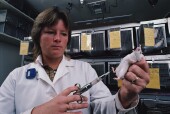
TUESDAY, Jan. 21, 2014 (HealthDay News) — Many pharmaceutical studies in animals that lead to trials in humans have serious design flaws, a new study suggests.
Researchers analyzed 63 animal studies of popular cholesterol-lowering drugs called statins — drugs such as Crestor, Lipitor and Zocor. Some of the studies were funded by the government and other non-industry sources, while others were paid for by drug companies.
Numerous design flaws were found in the studies regardless of who funded them, found the researchers, led by Lisa Bero, a pharmacologist at the University of California, San Francisco, School of Pharmacy.
For example, animals were not randomly divided into treatment or placebo groups — a requirement of high-quality clinical trials — in about half the studies, the researchers said.
And in about half the studies, the animals were identifiable to the person giving them the drug or placebo, Bero’s team found. That’s a violation of a research practice called “blinding,” in which researchers do not know which animal or human got the treatment and which did not.
In addition, many of the studies did not explain the criteria for including or excluding animals, the researchers said. Many also did not properly explain treatment changes made among groups of animals that were being given the drugs.
Finally, the harmful side effects — the “adverse events” — of the drugs were not investigated.
“Not a single animal study we looked at assessed adverse events following the statin intervention,” Bero said in a university news release.
“As toxicity data from animal studies must be submitted to drug regulatory authorities before a compound can proceed to testing in humans, it is surprising that so little data on harm appears in the published scientific literature,” she said.
Conclusions of all the studies tended to be favorable, the researchers said. But compared to studies funded by government and other nonindustry sources, studies funded by drug companies were more likely to present favorable conclusions — even when the data was less favorable.
These findings highlights the role of “spin” in communicating study findings, Bero said.
The study was published online Jan. 21 in the journal PLoS Biology.
More information
The U.S. Food and Drug Administration explains how drugs are developed and approved.
Copyright © 2025 HealthDay. All rights reserved.

